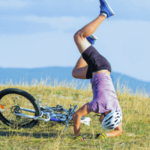Common Mountain Bike Knee Injuries: There are several common knee injuries that can occur while mountain biking. The most common is patellar tendonitis, which is inflammation of the tendon that connects the kneecap to the shinbone. This condition is caused by overuse and can be very painful.
Other common knee injuries include meniscus tears, ligament sprains, and fractures. These injuries can all be prevented by wearing proper protective gear and using the correct technique when riding. Mountain biking is a great way to get exercise and enjoy the outdoors, but it’s not without its risks. One of the most common injuries among mountain bikers is knee pain. There are a few different types of knee injuries that are common among mountain bikers.
The first is patellar tendonitis, which is inflammation of the tendon that connects the kneecap to the shinbone. This type of injury is often caused by overuse or repetitive stress on the knee joint. Symptoms include pain and stiffness in the front of the knee, especially when climbing hills or stairs.
Another common mountain bike knee injury is iliotibial band syndrome (ITBS). This condition is caused by inflammation of the iliotibial band, a thick strip of tissue that runs from the hip to the outside of the knee. ITBS can be caused by overuse, improper alignment of the hips or knees, or tightness in the muscles and connective tissues around the hip and thigh.
Symptoms include pain on the outside of the knee, especially when bending or straightening the leg. If you experience any pain or discomfort in your knees while mountain biking, it’s important to see a doctor or physical therapist for an evaluation. They will be able to determine if you have one of these common injuries and create a treatment plan to help you recover quickly and safely so you can get back out on your bike!
Mountain Biking Spinal Injuries
Mountain biking is a popular outdoor activity that can be enjoyed by people of all ages and skill levels. However, like any sport, there is always the potential for injury. One of the most serious injuries that can occur while mountain biking is a spinal injury.
Spinal injuries can range from minor to severe, and in some cases can even be life-threatening. The most common type of spinal injury in mountain biking is a compression fracture, which occurs when the vertebrae are crushed together. This type of injury can cause pain, numbness, and paralysis depending on the severity.
Another type of spinal injury that can occur while mountain biking is an incomplete spinal cord injury. This means that the spinal cord has been damaged but not completely severed. Incomplete spinal cord injuries often result in partial paralysis below the level of the injury.
The best way to prevent a spinal injury while mountain biking is to wear proper safety gear at all times. A helmet is absolutely essential in protecting your head and neck in case of a fall or collision. Wearing pads on your elbows and knees will also help reduce the risk of injuries if you do happen to take a spill off your bike. If you do suffer a spinal injury while mountain biking, it’s important to seek medical attention immediately.
Mountain Biking Injury Statistics
Mountain biking is an increasingly popular sport, but it’s not without its risks. A new study has found that the number of people being treated for mountain biking injuries has increased substantially over the past decade. The study, which was conducted by the University of Colorado at Boulder, looked at data from 100 hospitals across the United States.
They found that the number of mountain biking injuries treated each year rose from about 6,000 in 2001 to nearly 24,000 in 2013. That’s an increase of almost 400%. There are a few possible explanations for this sharp increase. First, as mentioned above, mountain biking is becoming more popular. More people means more chances for accidents. Second, bikes are getting better and riders are pushing themselves harder than ever before.
Better bikes and more experienced riders mean that people are able to ride faster and take on more challenging terrain, which can lead to crashes and injuries. Whatever the reasons for the increase in injuries may be, one thing is clear: mountain biking can be a dangerous sport. If you’re going to ride, make sure you wear proper safety gear and always ride within your abilities. And if you do end up getting injured, don’t hesitate to seek medical help right away.
Mtb Injury
Mtb Injury Mountain biking is an increasingly popular sport that carries with it a risk of serious injury. A recent study found that the rate of mountain bike injuries has more than doubled in the last decade.
The most common type of mountain bike injury is a collision with another object, followed by overuse injuries and then falls. The most common areas of the body injured are the head, neck, and shoulders, followed by the knees and lower legs. Most mountain bike injuries can be prevented with proper safety gear, such as a helmet and protective pads, and by riding within your abilities. If you do suffer an injury while mountain biking, it’s important to seek medical attention immediately.
Common Mountain Bike Shoulder Injuries
The most common mountain bike shoulder injuries are caused by falls and collisions. The shoulder is a very vulnerable joint, and when it is hit hard enough, the bones can break or dislocate. This can lead to serious pain and disability.
There are several ways to prevent shoulder injuries while mountain biking. First, always wear a helmet. This will help protect your head and neck in the event of a fall. Second, be aware of your surroundings and try to avoid obstacles that could cause you to lose control of your bike. Third, ride at a safe speed and don’t take unnecessary risks. If you do fall, try to relax and roll with the impact to minimize the risk of injury.
If you do suffer a shoulder injury, it’s important to seek medical attention as soon as possible. Depending on the severity of the injury, you may need surgery or other treatment to repair the damage. In some cases, such as with a dislocated shoulder, physical therapy may be necessary in order to regain full use of the joint. No matter how careful you are, accidents can happen while mountain biking.
Mountain Biking Accident
Mountain biking is an adventurous sport that often comes with a few risks. Unfortunately, sometimes these risks can result in accidents. If you find yourself in a mountain biking accident, there are a few things you should do to ensure your safety and the safety of those around you.
First, it is important to stay calm. This can be difficult after an accident, but it is important to assess the situation and make sure everyone is okay before panicking. Once you have determined that everyone is safe, you can then assess the damage to yourself and your bike.
If you or your bike are injured, it is important to seek medical help right away. Even if the injuries seem minor, it is always better to err on the side of caution and get checked out by a professional. If possible, it is also a good idea to take pictures of the scene of the accident as well as any injuries sustained.
This will be helpful for insurance purposes later on. Once everyone has been taken care of and the scene has been documented, you can then begin dealing with any legalities that may arise from the accident. This includes filing any insurance claims and speaking with lawyers if necessary. Depending on the severity of the accident, there may also be police involvement. No one ever wants to be in an accident while mountain biking, but unfortunately sometimes these things happen.
Downhill Mountain Biking Injury Statistics
According to a study conducted by the University of Colorado, Boulder, downhill mountain biking is associated with a high rate of injuries. In fact, the study found that over half of all mountain bike riders will suffer an injury while riding at some point during their lifetime. While the majority of these injuries are not serious, some can be quite severe.
The most common type of injury among mountain bikers is a broken bone, followed by bruises, cuts, and scrapes. Head injuries are also relatively common in this sport, and can often lead to concussions or even more serious brain damage. Fortunately, there are ways to reduce your risk of being injured while mountain biking.
Wearing protective gear such as a helmet and elbow and knee pads can help mitigate the severity of an injury if you do happen to crash. Additionally, staying aware of your surroundings and riding within your ability level can help you avoid situations that might lead to an accident.
Sprained Thumb Mountain Biking
A sprained thumb is one of the most common injuries that can occur while mountain biking. The good news is that it is usually not a serious injury and will heal with time and proper care. However, if you do not take the necessary precautions, a sprained thumb can become a chronic injury that will make it difficult or even impossible to continue mountain biking.
The first step in preventing a sprained thumb is to wear gloves while riding. This will help protect your hands in the event of a fall. It is also important to avoid gripping the handlebars too tightly.
A firm grip is necessary for control, but gripping the bars too tightly can put unnecessary pressure on the thumbs and cause them to bend awkwardly in a fall. If you do happen to fall and injure your thumb, it is important to seek medical attention right away. The sooner you are seen by a doctor, the better your chances are of avoiding long-term damage.
If you cannot get to a doctor immediately, there are some things you can do at home to reduce swelling and pain. Apply ice packs 20 minutes at a time every few hours and keep your hand elevated above heart level as much as possible. Wearing a splint or brace can also help stabilize the joint and prevent further damage.
With proper care, most sprained thumbs will heal within 2-4 weeks without any lasting effects. However, if you experience severe pain or numbness in your thumb or fingers, have difficulty moving your hand or wrist, or see signs of infection (redness, warmth, swelling), it’s important to see a doctor right away as these could be signs of more serious nerve or tendon damage.
Mountain Bike Deaths Per Year
Mountain biking is an increasingly popular outdoor activity, but it also comes with some risks. According to a study by the University of Colorado, there were approximately 27 mountain bike deaths in the United States in 2016. This number has been increasing over the years, and while it is still relatively low compared to other activities, it is important to be aware of the dangers involved in mountain biking.
Most of the deaths occurred on trails that were rated as difficult, and many of them were due to rider error. The most common mistakes included riding too fast for conditions, not paying attention to trail obstacles, and failing to yield to other trail users. Riders can reduce their risk by staying alert and riding within their abilities.
Wearing a helmet is also essential, as head injuries are one of the leading causes of death in mountain biking accidents. By understanding the risks involved in mountain biking and taking some basic precautions, riders can enjoy this great activity while staying safe.
Does Mountain Biking Hurt Your Knees?
Mountain biking is a great way to get outdoors and enjoy the scenery, but it’s also a great workout. However, some people worry that mountain biking may be bad for their knees. So, does mountain biking hurt your knees?
The short answer is no, mountain biking does not hurt your knees. In fact, mountain biking can actually help improve the strength and stability of your knees. Mountain biking requires you to use your leg muscles more than simply walking or running, which can help prevent knee injuries in the future.
However, there are a few things you should keep in mind if you’re new to mountain biking or if you have any existing knee pain or injuries. First, start off slowly and increase your intensity level gradually. You don’t want to overdo it and risk injuring yourself.
Second, make sure you wear proper footwear with good support to protect your knees. And finally, pay attention to your form while riding – avoid putting too much pressure on your knees by keeping them slightly bent when pedaling and using smooth, even strokes rather than jerky motions. If you follow these tips, then you’ll be able to enjoy all the benefits of mountain biking without having to worry about hurting your knees!
How Often Do Mountain Bikers Get Injured?
Mountain biking is an inherently dangerous sport. Though the risk of serious injury can be mitigated by following some basic safety guidelines, mountain bikers still get injured quite often. According to a study conducted by the University of Colorado, approximately 20% of all mountain bike riders will suffer an injury that requires medical attention each year.
Of those injuries, about 1% will be classified as “serious” (requiring hospitalization or resulting in permanent disability). The most common type of mountain bike injury is a collision with another object (usually another rider), followed by falls and then overuse injuries. The majority of mountain bike injuries are relatively minor, such as bruises, scrapes, and strains/sprains.
However, more serious injuries, such as concussions, fractures, and internal bleeding do occur. Given the high rate of injury among mountain bikers, it’s important to take some basic precautions while riding. Always wear a helmet and proper protective gear. Ride within your ability level and don’t take unnecessary risks. Be aware of your surroundings at all times and watch out for obstacles in the trail.
Is Mountain Bike Good for Knees?
Mountain biking is often lauded as a low-impact sport that is easy on the joints. However, there is some debate as to whether or not mountain biking is actually good for the knees. On one hand, mountain biking does require repetitive motion and can put stress on the knees.
In addition, if you are not properly positioned on the bike, you can put unnecessary strain on your knees. On the other hand, mountain biking can be a great way to build strength in your legs and knee area. Additionally, if you are careful about your form and positioning, you can avoid putting undue stress on your knees.
Ultimately, whether or not mountain biking is good for your knees depends on a number of factors. If you have any concerns about whether or not mountain biking may be harmful to your knees, it is best to consult with a doctor or physical therapist before embarking on this activity.
What is a Mtb Injury?
An MTB injury is an injury that occurs while mountain biking. Mountain biking is a sport that carries a risk of injuries, due to the nature of the terrain and the speed at which riders travel. While some injuries are minor and will heal quickly with rest and ice, others can be more serious, resulting in a concussion, broken bones, or even death.
It is important to always wear protective gear when mountain biking, including a helmet, as this can help to prevent or reduce the severity of injuries.
Conclusion
Mountain biking is a high-impact sport that can lead to a variety of knee injuries. The most common knee injuries in mountain biking are patellar tendonitis, iliotibial band syndrome, and anterior cruciate ligament (ACL) tears. Patellar tendonitis is an inflammation of the patellar tendon, which connects the kneecap to the shinbone.
Symptoms include pain and tenderness around the kneecap, as well as stiffness and weakness in the knee. Iliotibial band syndrome is an inflammation of the iliotibial band, a thick band of tissue that runs down the outside of the thigh from the hip to the shinbone. Symptoms include pain on the outside of the knee, as well as swelling and warmth.
ACL tears are one of the most serious knee injuries that can occur in mountain biking (or any other sport). The ACL is a major stabilizing ligament in the knee, and a tear can lead to severe instability and long-term problems. symptoms include severe pain, swelling, and instability in the knee joint. If you experience any knee pain while mountain biking, it’s important to see a doctor or orthopedic specialist for diagnosis and treatment.









1 thought on “Common Mountain Bike Knee Injuries”